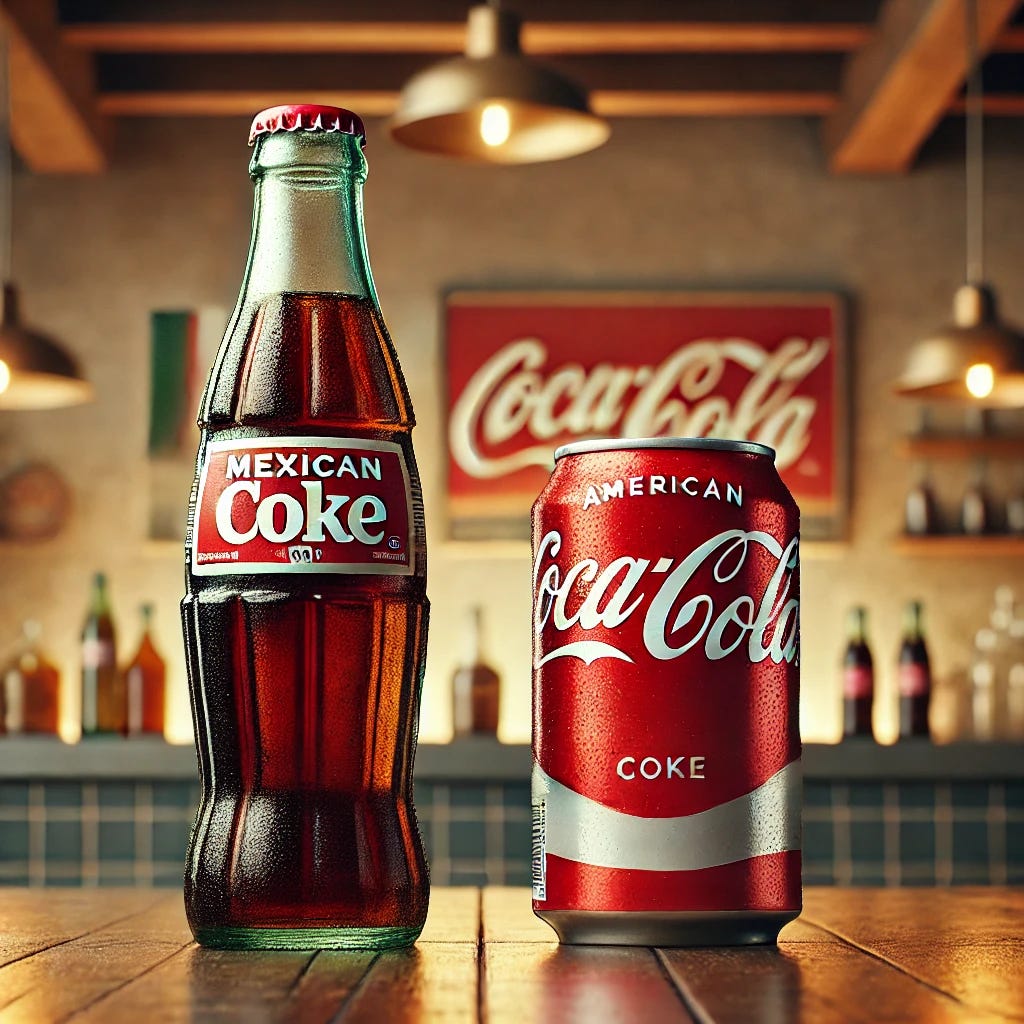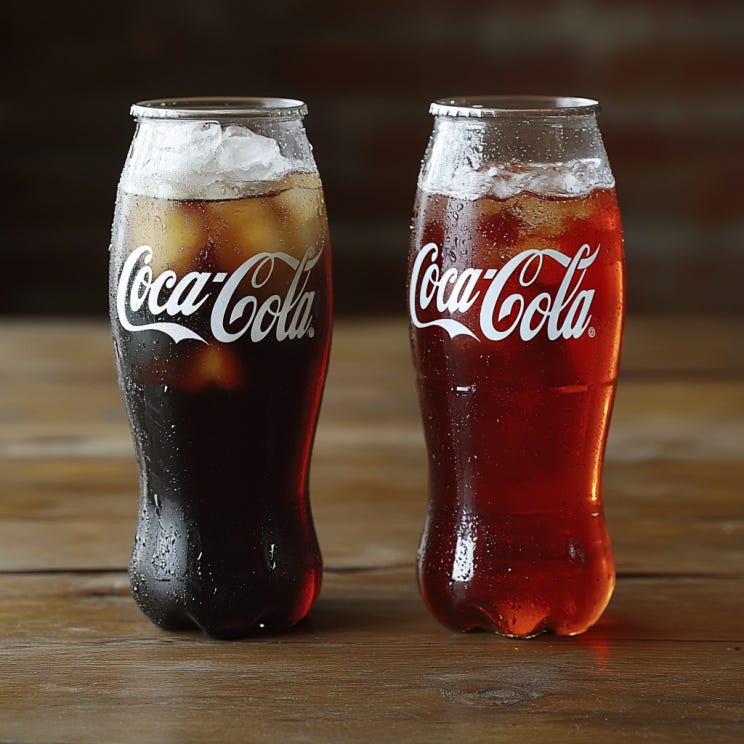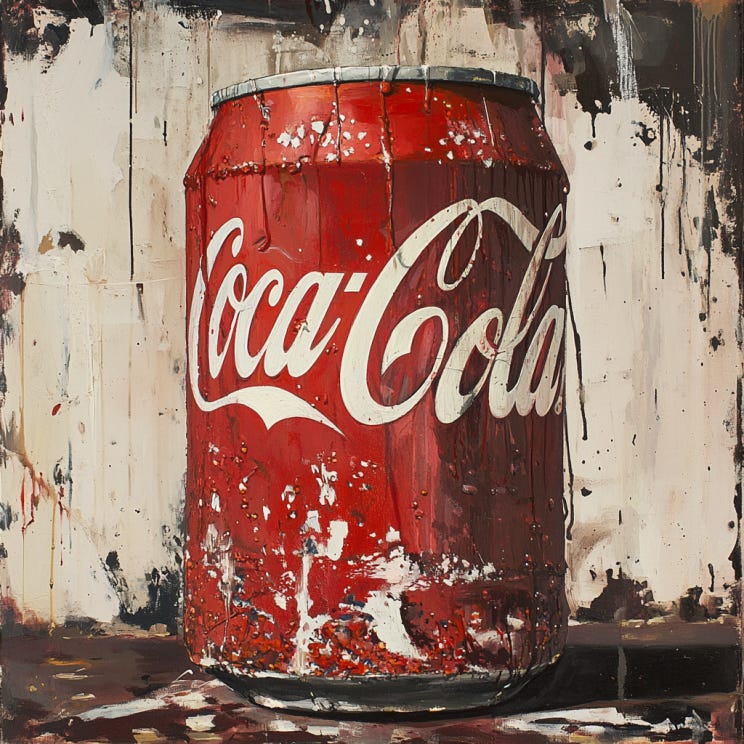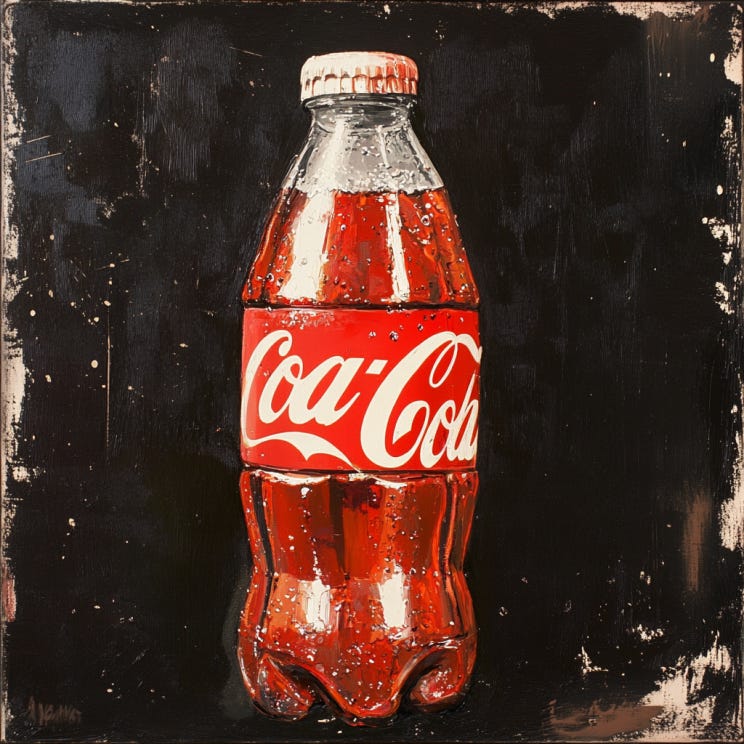Mexican Coke vs. American Coke: Taste, Health Effects, RFK Jr. Rumors, Cane Sugar vs. HFCS Debate
There is no evidence to suggest Mexican Coke is healthier or better tasting than American Coke... in fact, the opposite might be true.
Recently on X there was a rumor that, as HHS Secretary, RFK Jr. would require Coca-Cola (“Coke”) to remove high-fructose corn syrup (HFCS) and replace it with cane sugar.
Although this seems like something RFK Jr. might do as HHS Secretary, there is currently no actual evidence (as of December 1, 2024) to support the claim that this is RFK Jr.’s plan… so we shouldn’t assume this to be the case.
And while I think RFK Jr. has mostly nonsensical ideas to “MAHA”, I think the guy has good intentions and might make an effort to learn more along the way.
Trump’s selection of Jim O’Neill as HHS Deputy Secretary was excellent, as Jim is as good as it gets and could provide a rational counterweight to some of RFK Jr.’s kooky (scientifically-unsubstantiated) ideas.
Anyways – back to the topic: Mexican Coke vs. American Coke… is Mexico’s Coca-Cola really better tasting and healthier than the U.S. version?
And what would be the implications of switching from the U.S. Coke recipe to Mexican Coke recipe in the U.S. such as if forced by RFK Jr.?
Mexican Coke vs. American Coke (Comparison)
The primary difference between Mexican Coke and American Coke lies in the sweetener (cane sugar vs. HFCS), which influences the taste, calories, and perception.
Sodium content is higher in Mexican Coke, but both versions are otherwise similar in composition.
The choice between the two often comes down to personal taste preference.
Ingredients
The base ingredients of Mexican Coke and American Coke are nearly identical, with the primary difference being the type of sweetener used.
A.) Mexican Coke
Carbonated water
Cane sugar (pure)
Caramel color
Phosphoric acid
Natural flavors
Caffeine (approximately 34 mg per 12 oz)
B.) American Coke
Carbonated water
High fructose corn syrup (HFCS)
Caramel color
Phosphoric acid
Natural flavors
Caffeine (approximately 34 mg per 12 oz)
Nutritional Information
While similar in nutritional composition, some differences are evident:
A.) Mexican Coke (per 12 oz bottle)
Calories: 150
Total Sugars: 39g
Sodium: 85mg
Caffeine: 34mg
B.) American Coke (per 12 oz can)
Calories: 140
Total Sugars: 39g
Sodium: 45mg
Caffeine: 34mg
What are the key differences?
Sweetener: Mexican Coke uses pure cane sugar, American Coke uses high fructose corn syrup (HFCS).
Sodium Content: Mexican Coke contains 85mg of sodium, nearly 2x the 45mg in US Coke. This difference might subtly influence the taste.
Calories: Mexican Coke has 10 more calories per serving, likely due to the composition of cane sugar compared to HFCS.
Labeling: Mexican Coke (domestic) does not require caffeine content labeling. Exported versions to the US often include additional labels to meet FDA requirements.
Taste & Perception
Mexican Coke: Often described as having a smoother, less syrupy taste due to the cane sugar.
US Coke: The HFCS gives it a sharper sweetness and slightly different mouthfeel.
Scientific Analysis
Despite the use of different sweeteners, scientific studies have found that both versions contain similar levels of glucose and fructose.
The ratios, however, differ, which could contribute to the distinct taste.
Important Notes
Export vs. Domestic Mexican Coke: The export version sold in the US continues to use cane sugar. Since 2017, domestic Mexican Coke sold in Mexico may contain sucralose and has ~33.3% less sugar.
Caffeine Content: Both versions have a similar caffeine content (~34 mg per 12 oz serving), with no significant impact on taste or experience.
Which is Healthier: Mexican Coke vs. American Coke?
The Negligibly Healthier Choice: American Coke
While the differences are subtle, US Coke is slightly healthier than Mexican Coke based on its lower sodium and calorie content.
The type of sweetener—high fructose corn syrup (HFCS) vs. cane sugar—does not significantly impact health outcomes when caloric intake is controlled.
Sodium Content:
Mexican Coke contains 85mg of sodium per 12 oz bottle, nearly double the 45mg in US Coke.
Elevated sodium intake is linked to increased risk of hypertension and cardiovascular issues. Reducing sodium, even in small amounts, can benefit long-term health, particularly for individuals monitoring their sodium intake.
Calorie Count:
Mexican Coke provides 150 calories per serving, compared to 140 calories in US Coke.
While the 10-calorie difference is minor for a single serving, it could add up over time with regular consumption.
Sweetener Type:
The sweetener in Mexican Coke is cane sugar (sucrose), while US Coke uses HFCS-55.
Despite common perceptions, controlled human studies show no meaningful metabolic differences between these sweeteners. Biochemically, they function similarly in the body.
Supporting Evidence: Biochemistry of Cane Sugar vs. HFCS
Biochemical Breakdown
1. Cane Sugar (Sucrose)
Structure: A disaccharide composed of one molecule each of glucose and fructose (50:50 ratio).
Digestion: Broken down by the enzyme sucrase in the small intestine into free glucose and fructose molecules. This step is rapid and has no significant metabolic implications in healthy individuals.
2. HFCS-55 (High Fructose Corn Syrup)
Structure: A mix of 55% fructose and 45% glucose, already in free form.
Digestion: Requires no enzymatic breakdown, as it is absorbed directly into the bloodstream.
Metabolic Pathways
Once in the bloodstream, glucose and fructose follow identical metabolic pathways, regardless of their source.
Glucose:
Absorbed into body tissues via insulin-dependent GLUT4 transporters.
Metabolized through glycolysis to produce energy.
Excess glucose is stored as glycogen in the liver and muscles or converted to fat.
Fructose:
Primarily metabolized in the liver via GLUT5 transporters (insulin-independent).
Can be converted into: Glucose for energy, Lactate or glycogen, Fat through de novo lipogenesis (only significant with excessive intake).
Biochemical Comparison:
The slight difference in fructose:glucose ratios (50:50 for sucrose vs. 55:45 for HFCS) is not physiologically significant.
Both sweeteners lead to the same metabolic end products and processes.
Why HFCS vs. Cane Sugar Concerns are Misleading
A.) Misinterpretations in Research
Animal Studies:
Negative claims about HFCS often come from rodent studies using unrealistic doses or concentrations far exceeding human consumption.
Rodents metabolize sugars differently than humans, making these findings irrelevant to human health.
Correlation ≠ Causation: HFCS was introduced around the time obesity rates began rising, but these studies fail to control for:
Increased total calorie consumption.
Reduced physical activity.
Broader dietary changes.
Methodological Flaws:
Many studies comparing HFCS and sucrose fail to control for total calorie or sugar intake.
Properly controlled trials show no differences in metabolic outcomes between the two sweeteners.
B.) Human Research Findings
Systematic Review (American Journal of Clinical Nutrition, 2008): No significant differences between HFCS and sucrose in terms of:
Blood glucose and insulin responses.
Satiety hormones.
Energy intake or weight gain.
Calorie-Matched Studies: Show identical glycemic index, caloric impact, and metabolic pathways for both sweeteners.
C.) Practical Considerations: Sodium & Sugar Intake
Sodium Content & Health
US Coke’s 40mg lower sodium content per serving is the most significant differentiator.
Excess sodium intake is a well-documented risk factor for high blood pressure and cardiovascular disease. Over time, even small reductions in sodium can have meaningful health benefits.
Sweeteners Are Nutritionally Equivalent
The belief that cane sugar is "healthier" is driven more by marketing and consumer perception than scientific evidence.
In reality, both sweeteners contribute equally to overall calorie intake and carry the same risks when consumed in excess.
Why American Coke is Slightly Healthier
Lower sodium content: 40mg less sodium per serving reduces cardiovascular risk.
Slightly fewer calories: 10 fewer calories per serving may add up over time.
Equivalent sweetener effects: Cane sugar and HFCS are biochemically and metabolically equivalent when consumed in similar amounts.
While US Coke has a slight edge in health metrics, both versions should be consumed sparingly, as excessive sugar intake—regardless of the source—has far greater implications for health than these minor differences.
Which Really Tastes Better: Mexican or US Coke?
Taste Test Findings
Blind taste tests comparing Mexican Coke and American Coke have produced surprising results, challenging widely held assumptions about which version tastes better.
Serious Eats Blind Taste Test
Finding: American Coke was overwhelmingly preferred by testers, with a ratio of 2 to 1.
Participants were divided into 2 groups:
The Tasters: Focused on flavor and aroma. This group chose American Coke 7 out of 8 times.
The Feelers: Valued the tactile experience of drinking from a glass bottle. They consistently preferred any Coke served in a glass bottle, regardless of its origin.
Results:
The flavor of US Coke outperformed Mexican Coke among those prioritizing taste.
The preference for Mexican Coke often came from the experience of drinking from a glass bottle rather than the actual liquid.
Psychological Influence of Labeling
When participants were told which Coke they were drinking (accurately or falsely), they stuck to their preconceived preferences:
Those who believed they preferred Mexican Coke chose the drink labeled as Mexican, even if it was American Coke, and vice versa.
This highlights the power of branding and perception in shaping taste preferences.
Why the Perception of Mexican Coke as Better than American Coke Persists
The preference for Mexican or American Coke largely depends on psychological and experiential factors rather than actual flavor differences.
If you value pure flavor, U.S. Coke might be the winner.
If you prioritize the experience and feel, Mexican Coke in a glass bottle may enhance your enjoyment.
Ultimately, the choice comes down to personal preference, with evidence suggesting that branding and packaging play a significant role in shaping perceptions of taste.
1. Packaging & Presentation
Mexican Coke is typically sold in glass bottles, which are associated with a premium feel and nostalgic appeal.
Glass bottles may also affect the tactile experience, influencing the overall perception of quality.
2. Exotic & Exclusive Appeal
The relative rarity and "authenticity" of Mexican Coke in the US contribute to its perceived superiority.
Words like "refresco" and "no retornable" add to its exotic charm.
3. Cultural & Psychological Bias
Consumers often associate "real sugar" with better taste, even though scientifically, the differences in sweeteners are negligible.
The belief that Mexican Coke is "special" can override objective flavor evaluations.
4. Vacation Effect
On vacation, everything tends to feel better—food tastes more delicious, drinks seem more refreshing, and experiences are more memorable.
This psychological association can enhance the perception of Mexican Coke's quality and flavor, even when the actual taste differences are negligible.
Only Subtle Differences Between American & Mexican Coca-Cola (Health & Taste)
In the end, the differences between US Coke and Mexican Coke are minimal.
The choice often comes down to personal preference, with factors like packaging and context playing a larger role than the actual product inside the bottle.
Health
There are no meaningful differences in health effects between the two Cokes.
The U.S. Coke’s slightly lower sodium and calorie content makes it marginally healthier.
Taste
Subjective preferences vary, but blind tests show US Coke is often preferred for flavor.
The perception of Mexican Coke as better is influenced by packaging, nostalgia, and psychological biases, such as associations with vacations or the belief that cane sugar is superior.
How much would it cost Coca-Cola to replace HFCS with Cane Sugar in the U.S.?
Estimating the cost impact of replacing high fructose corn syrup (HFCS) with cane sugar in Coca-Cola involves several key factors, including the price difference between HFCS and cane sugar, the amount of sweetener used per product, and Coca-Cola’s production scale.
Cost Comparison
HFCS: Average price: $0.35 - $0.40 per pound (due to corn subsidies and domestic production efficiencies).
Cane Sugar: Average price: $0.50 - $0.60 per pound (varies based on tariffs, quotas, and global market rates).
The price of cane sugar is typically 25-50% higher than HFCS.
Sweetener Usage in Coca-Cola
Coke’s Sugar Content: A 12 oz Coke contains about 39 grams of sugar.
This translates to 0.086 pounds of sugar per can.
For production at scale, Coca-Cola produces billions of cans annually.
Cost Impact per Can (Est.)
Using HFCS: At $0.40 per pound, the cost of HFCS per can = $0.0344.
Using Cane Sugar: At $0.60 per pound, the cost of cane sugar per can = $0.0516.
Difference per can: $0.0172 (1.72 cents more per can).
Scaling to Annual Production
Coca-Cola sells approximately 1.9 billion servings per day globally, which includes all Coca-Cola products, but let's assume a portion is Coke Classic:
If 10% of these are 12 oz Cokes (approximately 190 million cans/day): Annual production: 69.4 billion cans.
Cost Increase with Cane Sugar: $0.0172 (extra cost per can) × 69.4 billion cans = $1.19 billion additional annual cost.
Other Considerations
Packaging & Distribution: Switching to cane sugar might require adjustments in supply chains, adding marginally to costs.
Consumer Price Impact: Coca-Cola would likely pass these costs on to consumers. If evenly distributed: 1.72 cents more per can could result in a price increase of $0.10-$0.20 per 12-pack or $0.02 per bottle.
Regional Variability: Countries with existing sugar tariffs or quotas might see even higher cost differences.
Takeaway: Replacing HFCS with cane sugar in Coca-Cola could increase production costs by an estimated $1.19 billion annually, resulting in a price increase of about 1.72 cents per can.
While this may seem minor on a per-unit basis, the cumulative cost at Coca-Cola’s scale is significant and would impact consumer prices and the broader economy.
What Happens if RFK Jr. Requires Coke to Replace HFCS with Cane Sugar in the U.S.?
Mandating a switch from high fructose corn syrup (HFCS) to cane sugar in Coca-Cola would have numerous consequences—most of which are driven by economic and political factors, rather than health or taste benefits.
1. No Significant Change in Taste (Possibly Worse)
Taste Impact: There is unlikely any major taste difference between U.S. and Mexico Coke. Some blind taste tests suggest U.S. Coke has superior taste and is preferred 2:1 over Mexican Coke. Replacing HFCS with cane sugar may alienate some consumers who are accustomed to the current formula.
For Regular Coke Drinkers: Most consumers likely wouldn’t notice a significant taste difference unless influenced by external factors like labeling or the cultural perception of “real sugar” being superior.
2. Higher Costs for Consumers
Cost of Sweeteners:
HFCS costs $0.35-$0.40 per pound, while cane sugar costs $0.50-$0.60 per pound.
This 25-50% price difference could result in Coca-Cola’s production costs increasing by $1.19 billion annually based on current production levels.
Price Increases:
Consumers would see a price hike of approximately $0.02 per can or $0.10-$0.20 per 12-pack, reflecting the increased cost of production.
Comparative Insight:
Mexican Coke, which uses cane sugar, is already more expensive in the U.S., demonstrating the financial impact of using cane sugar.
Impact on the U.S. Economy:
HFCS supports U.S. corn farmers, whose crops benefit from heavy subsidies.
3% of U.S. corn production goes to HFCS, with most used for livestock feed. While the direct economic effect of reducing HFCS demand might be small, it could ripple through the agricultural sector, reducing corn prices and impacting farmer income.
3. Regulation Without Evidence
Lack of Scientific Basis: Claims that HFCS is worse than cane sugar lack robust evidence:
Studies showing harm from HFCS often rely on rodent models with unrealistically high doses that do not reflect human consumption.
Well-controlled human studies find no significant differences in metabolic effects (e.g., insulin response, weight gain) between HFCS and cane sugar when caloric intake is matched.
Metabolic Equivalence: Both HFCS and cane sugar are metabolized into glucose and fructose, following identical biochemical pathways in the body. Their health impacts are virtually identical.
A Solution Without a Problem: Mandating the use of cane sugar would cater to unscientific fears fueled by anecdotal evidence or alt-health narratives, rather than addressing genuine public health concerns.
4. Historical & Political Context
Farm Subsidies:
Corn Subsidies: The U.S. spends over $10 billion annually subsidizing corn, with HFCS benefiting indirectly as a byproduct.
Sugar Tariffs: Since 1789, the U.S. has imposed tariffs on imported sugar, inflating domestic cane sugar prices and protecting American sugar producers.
International Policies: Mexico imposes high tariffs and quotas on HFCS, making cane sugar the cheaper sweetener for their market. This explains why Mexican Coke uses cane sugar.
Farm Subsidy Reform: If fairness or sustainability is the goal, reforming the entire farm subsidy system—including both corn and sugar—is a better approach than mandating specific sweeteners for private companies.
5. Consumer Choice & Market Freedom
Government Overreach: Mandating Coca-Cola to use cane sugar based on subjective preferences or unsubstantiated health claims would set a dangerous precedent for government control over private businesses.
Alternative Options: Concerned about HFCS? Don’t drink Coke.
Market Innovation: A free-market approach allows consumers to vote with their dollars, incentivizing companies to adapt to demand rather than regulatory coercion.
Mandating Cane Sugar as Coke’s Sweetener Lacks Logic & Evidence
Mandating a switch from HFCS to cane sugar in Coca-Cola would:
Fail to improve health outcomes: HFCS and cane sugar are metabolically equivalent. There are no human data to suggest that one is healthier than the other when we control for total calories.
Lead to higher consumer costs: Increased production costs would be passed on to consumers. Though this may not be too crazy, it would be higher cost.
Harm U.S. farmers: Reduced HFCS demand would impact corn producers and ripple through the agricultural sector.
Encourage unnecessary regulation: Catering to unfounded fears and subjective biases undermines market freedom and stifles innovation.
Remember: nobody forces you to drink Coke…
If you are concerned about HFCS in Coke – luckily nobody has ever or will ever force you to drink Coke.
Regulating the way a private company does business because you think that cane sugar (1) tastes better (subjective) and/or (2) is healthier (without concrete evidence) – is totalitarianism.
Currently there is no compelling: logical argument (given the metabolic biochemical breakdown) or scientific evidence to support the idea that Mexican Coke is healthier than American Coke.
Remember, you have the option to drink Coke or not drink Coke… you can have water, tea, coffee, other soda brands, sports drinks, etc.
I’m staunchly against increased unnecessary regulation.
Let the free market decide – not alternative health gurus that spam misleading data (e.g. rat studies, correlational studies, etc.) on social media or RFK Jr.









